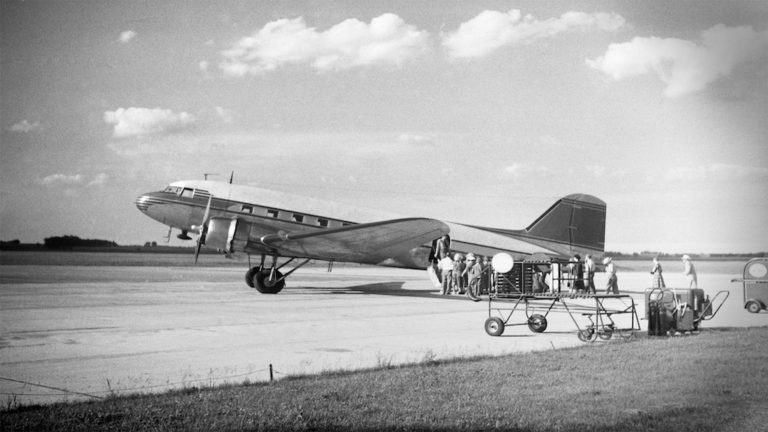Unsolved: The Mysterious Disappearance of Santiago Flight 513

On September 4, 1954, Santiago Airlines Flight 513 departed from Aachen, West Germany, destined for Porto Alegre, Brazil. The flight should have taken around 18 hours.
Instead, it took 35 years. On October 12, 1989, without any contact with air traffic controllers, Santiago Flight 513 was spotted circling the Porto Alegre airport, where it eventually made a successful landing. Witnesses at the airport reported an eerie sense of disbelief as the ghostly plane descended, unannounced and seemingly out of nowhere, stirring questions that no one was prepared to answer. How did Santiago Flight 513 disappear so suddenly, only to reappear decades later in such an inexplicable manner?
Flight 513: The Plane That Never Arrived
Santiago Flight 513’s journey began like any other flight from that era. Piloted by Captain Miguel Victor Cury, the aircraft had been checked, cleared, and prepped for its scheduled 18-hour flight from Aachen, Germany, to Porto Alegre, Brazil. The plane, a Lockheed Super Constellation, was known for handling long flights, was in top condition, and had taken similar routes several times in the past.
With 88 passengers and four crew members on board, the plane set off smoothly. Passengers likely settled into the flight, unaware of any unusual circumstances or issues. But somewhere over the Atlantic Ocean, all contact with Santiago Airlines Flight 513 ended without warning. Attempts to reach the crew through radio communications failed, and the sudden silence led to a number of search and rescue operations. Rescue teams searched vast stretches of ocean for days on end, holding out hope for survivors, however, no trace of the aircraft or its passengers could be found. The routine flight had inexplicably vanished, leaving behind only questions.
Another of Several Unsolved Aviation Mysteries
Throughout aviation history, it’s not unheard of for planes to disappear, though there’s usually evidence of what probably happened during those events to indicate that a plane crash occurred — debris, luggage, or, at a minimum, records of the pilot radioing for help.
Then there are those aircraft that set off, traveling from point A to point B, and are never heard from again, with nothing left behind, no reports of distress — not even poor weather conditions to pin the blame on. These stories, though puzzling and eerie, have occurred often enough to have attracted the expertise of scientists and meteorologists (along with other theorists), looking for a pattern among the disappearances. Perhaps the most famous of these incidents are tales from the Bermuda Triangle, the legendary vortex where aircraft and ships just seem to vanish without a trace.
It was thought that the Santiago Flight 513 mystery would go the way of the unexplained vanishing aircraft — after all, no one expects an airplane to finally land after 35 years missing. And it, too, disappeared without a trace, devoid of any communication with airport bases, and showing no signs of distress. The calm departure and lack of distress signals made this disappearance all the more unsettling for investigators and family members.
The Eerie Arrival of Santiago Airlines Flight 513
On October 12, 1989, Santiago Flight 513 mysteriously reappeared. The plane was first noticed circling Porto Alegre’s airport before making a controlled descent to the runway. No communication had been received from the crew, and there were no signs of distress or trouble. When airport authorities approached the plane, they were baffled to discover that it belonged to Santiago Airlines—a company that had ceased operations in 1956.
Upon opening the doors, the scene inside revealed the skeletal remains of all 92 passengers and crew, still strapped into their seats. The skeletal body of Captain Miguel Victor Cury was found in his pilot’s seat, hands on the controls. The aircraft’s engine was still humming, a detail that left authorities baffled. The discovery quickly reached the public as well as investigators, prompting more questions than answers. How could a plane, missing for 35 years, return with its passengers in skeletal form, as though no time had passed?
What Happened to Santiago Flight 513?
The mysterious return of the Santiago 513 flight has left experts, officials, and the public questioning what we know about aviation as well as time. How could a plane disappear without a trace, only to reappear 35 years later under such chilling circumstances? This event has sparked numerous theories, from government cover-ups to the possibility of wormholes and time travel. While no explanations have been officially confirmed, the strange details surrounding Flight 513’s case have surfaced several possible explanations.
Could It Be a Government Cover-Up?
While the Brazilian government did investigate this strange occurrence, it refused to offer any explanations or theories, much less draw any conclusions. Officials eventually admitted that the plane had appeared suddenly in the skies and landed successfully — a write-off that has resulted in many people suspecting government involvement in the disappearance.
Such unresponsiveness — interpreted as secrecy — from the government has evoked ire from the public over the years. Roderigo de Manha, a former physics professor in Porto Alegre, addressed the public’s concern, saying, “The public has a right to know everything about this plane, and the government has a duty to tell them.”
Spokespersons like Manha have been joined by others, including paranormal researcher Dr. Celso Atello, in calling for full disclosure. Atello has speculated that the government may be hiding concrete evidence of wormholes, suggesting that Santiago Flight 513 could have been trapped in one for more than three decades. The notion that such a powerful natural or supernatural force could exist, and remain concealed, has kept this conspiracy theory alive.
Dr. Atello said, “It was piloted by the skeleton of its captain and all the crew, and passengers were dead, too. Officials don’t want to discuss explanations. But they cannot deny that this airplane has defied the laws of space and time. And God only knows how a skeleton managed to land it.”
Wormholes and Time Travel: A Possible Explanation?
When it comes to cases of disappearing aircraft, one theoretical explanation commonly arises — that they are disappearing into wormholes or some sort of time warp. According to the Scientific American, “Wormholes are solutions to the Einstein field equations for gravity that act as ‘tunnels,’ connecting points in space-time in such a way that the trip between the points through the wormhole could take much less time than the trip through normal space…[and can] behave as ‘shortcuts’ in space-time.”
And because such notable scientists as Stephen Hawking entertain that wormholes might actually exist, those intrigued by unsolved aviation mysteries often contemplate how the theory would apply to various cases of missing aircraft over the years, including the many disappearances in the Bermuda Triangle. Over the Atlantic Ocean, the wormhole theory could explain much of what has transpired for decades, if not centuries, in the Bermuda Triangle.
Perhaps the wormhole theory describes the disappearance and reappearance of Santiago Flight 513 more accurately than other incidents, though, since the flight actually returned more than three decades later. Most disappearances are never resolved. Yet this case, where the plane reappeared, complete with skeletal remains, challenges our scientific understanding in unexplainable ways.
However, the presence of skeletons on the plane remains a baffling detail that no one has been able to explain. The shocking discovery of a fully intact aircraft with skeletal passengers fuels ongoing speculation that some force beyond our comprehension may have been at work.
Santiago Flight 513’s Mystery Continues
To anyone who wasn’t present in Porto Alegre to witness, first-hand, the arrival of a plane full of skeletons on the tarmac, the story of Santiago Flight 513 is easy to dismiss as a hoax, work of fiction, or urban legend. However, for those who have delved deeply into aviation lore, the disappearance and unexpected return of Santiago Airlines Flight 513 remains an unparalleled mystery, something only seen in an episode of The Twilight Zone. But how many times can accounts of disappearing aircraft (and watercraft) surface without any explanation before people stop calling them legends or hoaxes?
After all, it’s not as though these incidents are small and insignificant — thousands of lives have been lost to these strange occurrences. Whether the losses can be attributed to wormholes, government cover-ups, or something else, the minimum that should be said is that something strange has happened, and, when it comes to the mystery of Santiago Flight 513, perhaps it’s time to broaden everyone’s sense of what constitutes reality.
What Happened to Santiago Flight 513?
There was nothing abnormal about the aircraft, the crew, or the passengers. Santiago Flight 513 had taken many similar intercontinental flights across the Atlantic Ocean as it did on the day it went missing. On this particular fateful trip in early September 1954, the flight took off with 88 passengers and four crew members.
When it went missing over the Atlantic Ocean, emergency search and rescue teams scoured the area, but to no avail, eventually giving up the aircraft, and everyone aboard, for lost.

It would be an understatement to say that when Flight 513 flew into Porto Alegre it was unexpected. At first, authorities demanded to know why its pilot had flown in without warning.
But when they approached the craft and took note of its age, they were baffled to discover that it belonged to Santiago Airlines, an airline that had shut its doors in 1956.
Upon opening the doors, authorities found something still more shocking: the skeletons of 92 people, buckled into their seats. The skeletal body of Captain Miguel Victor Cury was found in his pilot’s seat, hands on the controls, with the engine still humming.
Could It Be a Government Cover-Up?
While the Brazilian government did investigate this strange occurrence, it refused to offer any explanations or theories, much less draw any conclusions. All officials eventually admitted was that the plane had appeared suddenly in the skies and landed successfully — a write-off that has resulted in many people suspecting government involvement in the disappearance.
Such unresponsiveness — interpreted as secrecy — from the government has evoked ire from the public over the years. Roderigo de Manha, a former physics professor in Porto Alegre, came out saying, “The public has a right to know everything about this plane, and the government has a duty to tell them.”
Spokespersons like Manha have been joined by others calling for full disclosure, including Dr. Celso Atello, a paranormal researcher, in speculating that the government is actually hiding concrete evidence that wormholes exist, and that the plane had been lost in one for more than three decades.
Dr. Atello said, “It was piloted by the skeleton of its captain and all the crew, and passengers were dead, too. Officials don’t want to discuss explanations. But they cannot deny that this airplane has defied the laws of space and time. And God only knows how a skeleton managed to land it.”
What Is a “Wormhole”?
When it comes to cases of disappearing aircraft, one theoretical explanation commonly arises — that the craft are disappearing into wormholes. According to the Scientific American, “Wormholes are solutions to the Einstein field equations for gravity that act as ‘tunnels,’ connecting points in space-time in such a way that the trip between the points through the wormhole could take much less time than the trip through normal space…[and can] behave as ‘shortcuts’ in space-time.”
And because such notable scientists as Stephen Hawking entertain that wormholes might actually exist, those intrigued by unsolved aviation mysteries often contemplate how the theory would apply to various cases of missing aircraft over the years, including the many disappearances in the Bermuda Triangle. Over the Atlantic Ocean, the wormhole theory could possibly explain much of what has transpired for decades, if not centuries, in the Bermuda Triangle.
Perhaps the wormhole theory describes the disappearance and reappearance of Santiago Flight 513 more accurately than other incidences, though, since the flight actually returned more than three decades later. Most disappearances are never resolved.
But it still doesn’t make sense why the plane was found with skeletons — and it’s a bizarre point no one seems able to explain.
To anyone who wasn’t present in Porto Alegre to witness, first-hand, the arrival of a plane full of skeletons on the tarmac, the story of Santiago Flight 513 is easy to dismiss as a hoax. But how many times can accounts of disappearing aircraft (and watercraft) surface without any explanation before people stop calling them legends or hoaxes?
After all, it’s not as though these incidents are small and insignificant — thousands of lives have been lost to these strange occurrences. Whether the losses can be attributed to wormholes, government cover-ups, or something else, the minimum that should be said is that something strange has happened, and perhaps it’s time to broaden everyone’s sense of what constitutes reality.
What's Happened Since CERN Fired Up the LHC Again?

The Large Hadron Collider was fired up for the third time, as scientists search for “new physics.”
Run by the European Organization for Nuclear Research, or CERN, near Geneva, Switzerland. The purpose of the collider is to allow scientists to test theories and predictions of particle physics and find new physics.
Completed in 2008, the Large Hadron Collider has had two “operational runs,” from 2009 to 2013, and 2015 to 2018. Now this month, after a long hiatus to improve and upgrade data collection and detectors, the Large Hadron Collider is at it again.
As the journal Nature reports, the first two operational runs tested and explored “known physics.” The discovery of the Higgs Boson particle, or “god particle,” in 2012 was part of that work and reaffirmed current models of how the universe works. This time they are looking for new physics and unknowns such as dark matter.




































